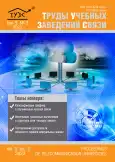Methodology for Accounting the Influence of Parameters of a Spherical Underlying Surface with Finite Conductivity on VLF Antennas Characteristics
- Authors: Tipikin A.A.1, Potapov D.S.1
-
Affiliations:
- Naval Academy named after Admiral of the Fleet of the Soviet Union N.G. Kuznetsov
- Issue: Vol 9, No 3 (2023)
- Pages: 60-66
- Section: Articles
- URL: https://journals.rcsi.science/1813-324X/article/view/254376
- ID: 254376
Cite item
Full Text
Abstract
About the authors
A. A. Tipikin
Naval Academy named after Admiral of the Fleet of the Soviet Union N.G. Kuznetsov
Email: alextip@mail.ru
ORCID iD: 0000-0002-0940-4285
D. S. Potapov
Naval Academy named after Admiral of the Fleet of the Soviet Union N.G. Kuznetsov
Email: denpotapow@yandex.ru
ORCID iD: 0009-0008-2289-1576
References
- Bradley P.A. IRI and VLF/LF radio service planning // Advances in Space Research. 2001. Vol. 27. Iss. 1. PP. 145–152. doi: 10.1016/S0273-1177(00)00150-2
- Cohen M.B., Inan U.S., Paschal E.W. Sensitive Broadband ELF/VLF Radio Reception with AWESOME instrument // IEEE Transactions on Geoscience and Remote Sensing. 2010. Vol. 48. Iss. 1. PP. 3–17. doi: 10.1109/TGRS.2009.2028334
- Lynn K. VLF Waveguide Propagation: The Basics // Proceedings of the 1st International Conference on Science with Very Low Frequency Radio Waves: Theory and Observations. 2010. Vol. 1286. Iss. 1. PP. 3–41. doi: 10.1063/1.3512893
- Pal S., Basak T., Chakrabarti S.K. Results of Computing Amplitude and Phase of the VLF Wave Using Wave Hop Theory // Advances in Geosciences. 2011. Vol. 27. PP. 1–11. doi: 10.1142/9789814355414_0001
- Bilitza D. IRI the international Standard for the ionosphere // Advances in Radio Science. 2018. Vol. 16. PP. 1‒11. doi: 10.5194/ars-16-1-2018
- Fron A., Galkin I., Krankowski A., Bilitza D., Hernández-Pajares M., Reinisch B., et al. Towards Cooperative Global Mapping of the Ionosphere: Fusion Feasibility for IGS and IRI with Global Climate VTEC Maps // Remote Sens. 2020. Vol. 12. Iss. 21. P. 3531. doi: 10.3390/rs12213531
- Galkin I., Fron A., Reinisch B., Hernández-Pajares M., Krankowski A., Nava B., et al. Global Monitoring of Ionospheric Weather by GIRO and GNSS Data Fusion // Atmosphere. 2022. Vol. 13. Iss. 3. P. 371. doi: 10.3390/atmos13030371
- Типикин А.А., Потапов Д.С. Методика оценки электрических характеристик почвы на трассе распространения земных радиоволн // Техника радиосвязи. 2022. № 1(52). С. 19‒29. doi: 10.33286/2075-8693-2022-52-19-29
- Типикин А.А. Методика формирования глобальных цифровых карт электрических характеристик подстилающей поверхности в диапазоне очень низких частот // Информатика, телекоммуникации и управление. 2022. Т. 15. № 1. С. 7‒18. doi: 10.18721/JCSTCS.15101
- Рекомендация МСЭ R P.684-7 (9/2016). Прогнозирование напряженности поля на частотах ниже приблизительно 150 кГц.
- Wait J., Conda A. Pattern of an antenna on a curved lossy surface // IRE Transactions on Antennas and Propagation. 1958. Vol. 6. Iss. 4. PP. 348–359. doi: 10.1109/TAP.1958.1144610
- Hyovalti D.C. Computations of the antenna cut-back factor for LF radio waves. Technical note №330. Boulder Laboratories, 1965.
- Knight P. MF propagation: a wavehop method for ionospheric field strength prediction // BBC eng. 1973. Vol. 100. P. 22–34.
- Coleman C.J. Analysis and Modeling of Radio Wave Propagation. Cambridge: Cambridge University Press, 2017. 296 p.
- Gonzalez G. Advanced Electromagnetic Wave Propagation Methods. Boca Raton: CRC Press, 2022. 708 p.
- Типикин А.А., Пыков Е.В. Уточненная модель высоты точки отражения для методики прогнозирования энергетических параметров радиотрасс в диапазоне очень низких частот // Труды всеармейской научно-практической конференции «Инновационная деятельность в вооруженных силах Российской Федерации». СПб.: ВАС, 2022.
- Макаров Г.И., Новиков В.В., Рыбачек С.Т. Распространение радиоволн в волноводном канале Земля–ионосфера и в ионосфере. М.: Наука, 1994. 152 с.
- Типикин А.А., Пыков Е.В., Розанов А.А. Модифицированная методика расчета дифференциальных временных задержек лучей в лучевой модели распространения радиоволн ОНЧ диапазона // Сборник трудов научно-технической конференции «Интеллектуальные разработки в интересах строительства и развития Военно-морского флота». 2022. С. 47–56.
Supplementary files






